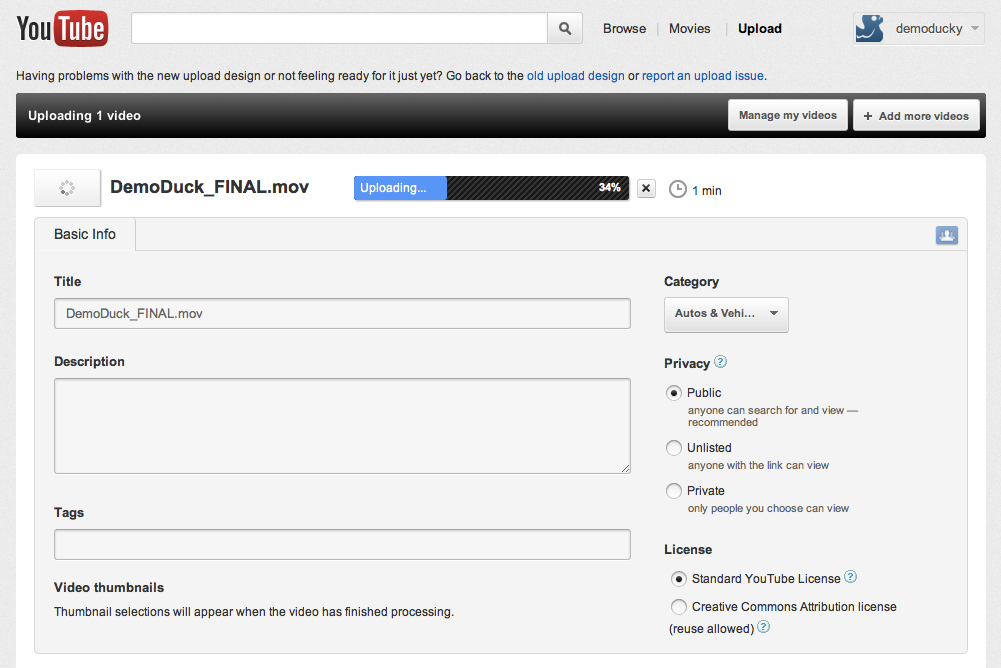Last week we published part one of our Beginner’s Guide to Online Video Marketing. If you haven’t read it yet, make sure to start there!
You’ve made your commercial video and decided to upload it to YouTube, but you’re not done yet. Optimizing your video for search engines is an important part of the process. Just like any other content, video is dependent on search engines to get eyeballs, so good SEO is vital to getting your marketing video seen by your target market. Video SEO may sound intimidating, but it’s a lot easier to manage than you’d think.
SEO for Videos
Search engine optimization is every bit as important in video marketing as it is in any other type of online marketing, though the particulars are a little bit different. Google and other search engines can’t actually index the content of your video – yet. They rely on text indicators to tell them what your video is about and whether someone will be interested in it. Whether you’re serving up your video on YouTube, your own site or another video hosting service, there are a few steps you should take to make sure that Google, YouTube, Yahoo! and Bing can find it.
YouTube is more than just a video host. It’s also one of the largest search engines on the Internet. If you want your videos seen on YouTube, you need to create a video marketing SEO strategy that’s as carefully crafted as your website’s SEO strategy.
Subscribe to Demo Duck Monthly
Understand the Algorithm
While the exact algorithm that YouTube uses is a secret, it’s known that it takes these things into account:
- Title
- Descriptions
- Tags
- Number of Views
- Rating
The number of views and ratings are essentially outside your control, but the first three factors are completely up to you. In most cases, you’ll be directly entering the information when you upload your marketing video to your video host.
If you’re using YouTube, for example, your upload screen will look like this:

You can see that you have the option to edit the title of your video, add a description and define tags. Use these fields to get some SEO oomph behind your video. The more YouTube (and other search engines) can tell about your video from your description, title and tags, the easier it is for the site to serve it up when someone comes looking.
While you’re on the page, choose an appropriate category from the dropdown list and set the appropriate privacy and license setting for your video.
Finally, once your video is finished uploading, you’ll have the option to pick a thumbnail for it. While it’s not technically SEO, choosing an engaging and interesting thumbnail can make a huge difference in whether someone decides to click on your video or pass it by.
These tips can help you optimize your videos for search on YouTube.
Incorporate Keywords in Your Title
Both Google and YouTube will factor the title of your video highly when ranking it for searches. Use keywords in your title but make sure that it appeals to human eyes as well as search engines.
Tip: Google uses the first 48 characters (including spaces) as anchor text to your video. Use those 48 characters wisely. To avoid awkward truncation, limit your titles to fewer than 48 characters.
Optimize Your Description Text
Optimize the description of your video as carefully as you would any other text on any web page. Use keywords intelligently in your description, and include a clickable URL – with the keywords in the anchor text in the first line of the description tag. Keep the anchor tag to 27 characters or fewer to avoid truncation.
Include a Transcription
Search engines can’t “watch” your video, so all that great content is locked up inside it. Put it out there where Google and the others can find it by adding a transcription of your marketing video to link the content with the video and take advantage of search engine gold.
Tip: YouTube now allows you to upload a caption or transcript file with your video. Take advantage of it to add searchable text and describe what’s happening in your video. Some other video hosts also provide transcription or captioning capability.
Don’t Forget Offsite SEO for Videos
When a video goes viral, you can reap hundreds of thousands of clicks and hundreds of links. Jumpstart the SEO juice by sharing your videos on Facebook, Twitter and other social media sites, as well as via email and newsletters.
Tip: Get serious about social media marketing. Post your videos to your Facebook wall, Tweet them to followers and include links with thumbnails in your emails.
SEO for Self-Hosted Videos
Not on YouTube? Not a problem. The same principles and tips apply to self-hosted videos and to videos hosted on other hosting sites. Treat video content like you would any other content.
- Place each landing page video on its own dedicated landing page.
- Optimize the text on the page for the keywords you want to rank for.
- Include a transcription, description and keyword-optimized title.
- Create a video sitemap for your website. You’ll find everything you need to know about creating video sitemaps on the Google Support pages.